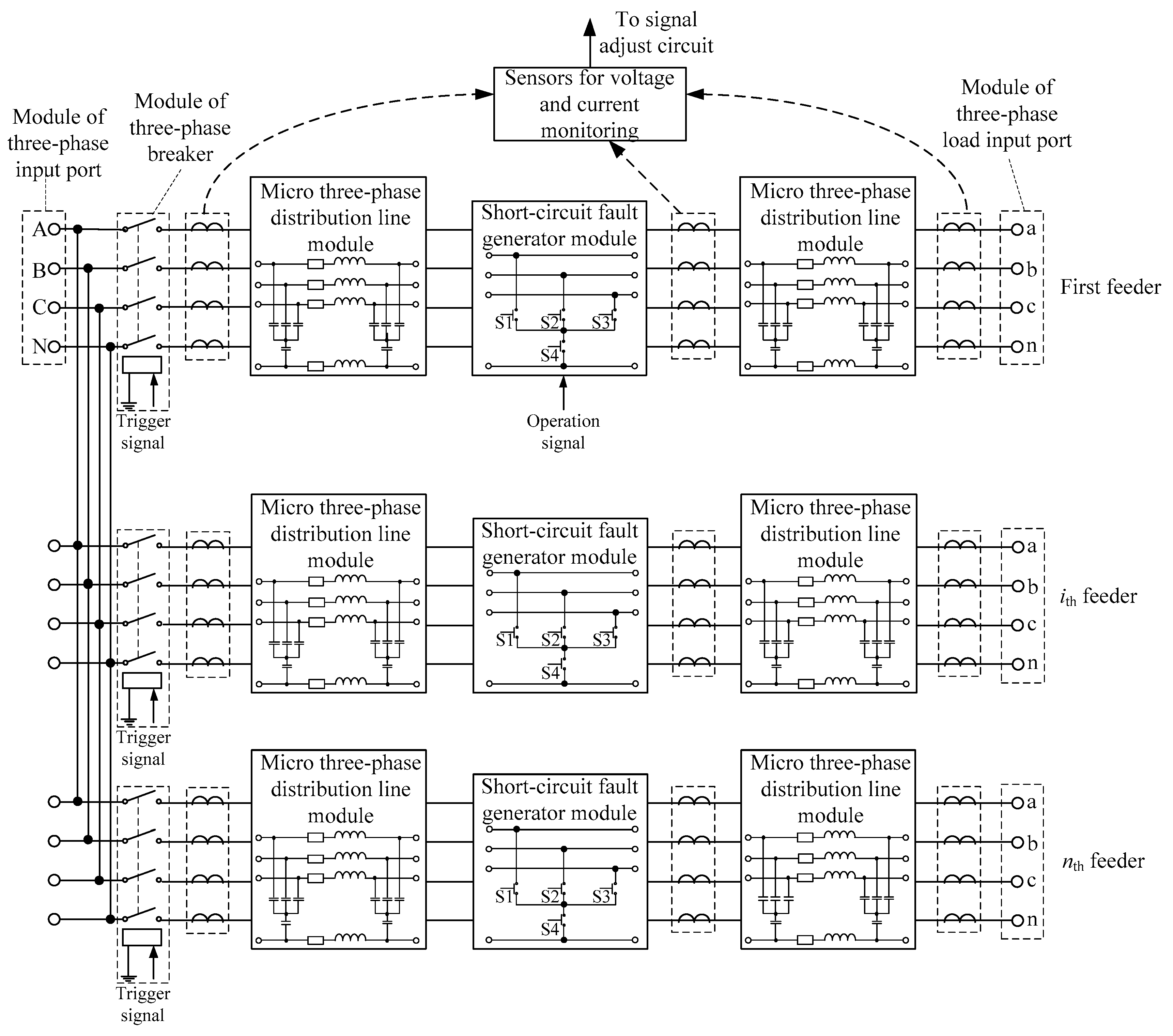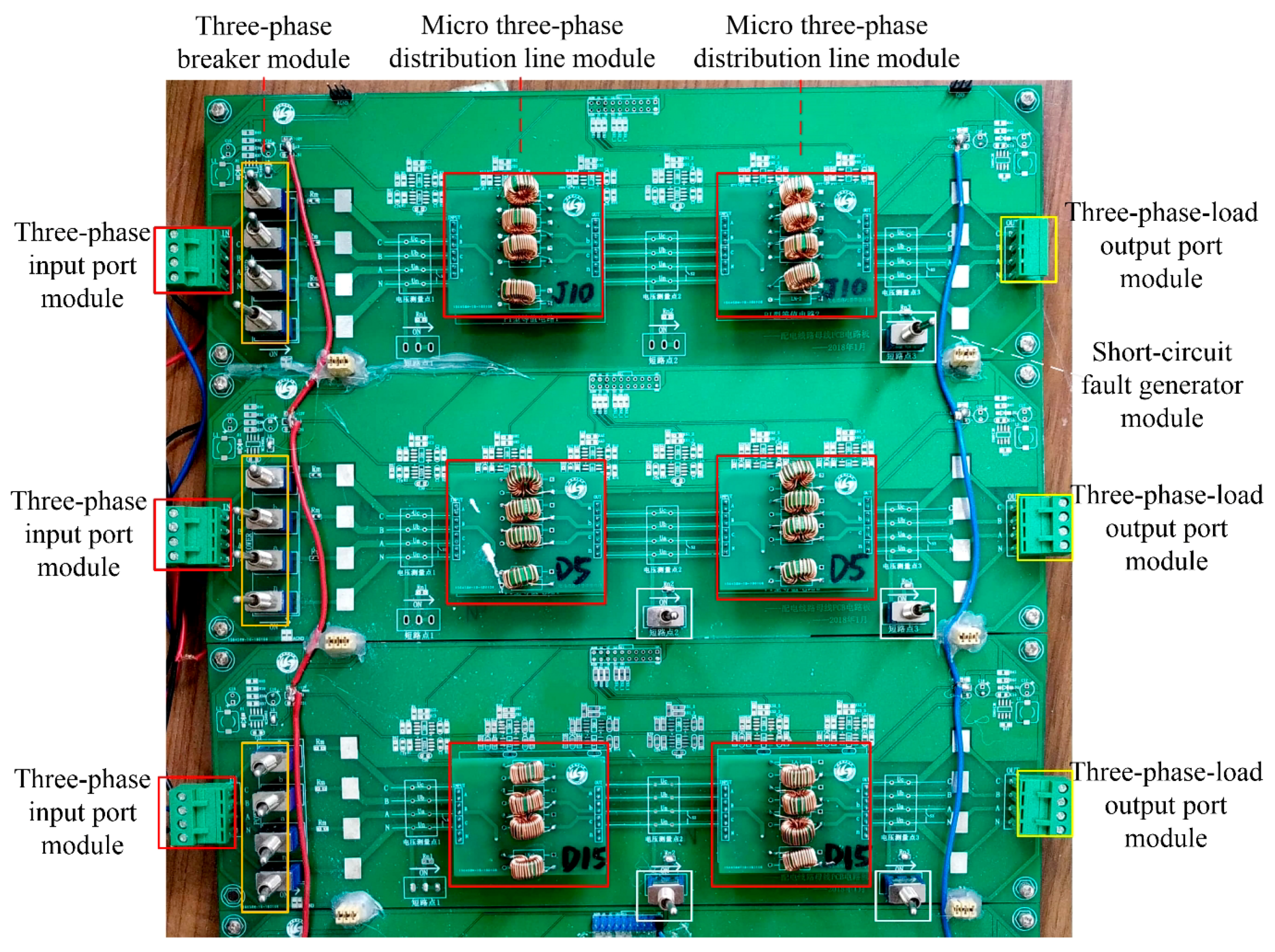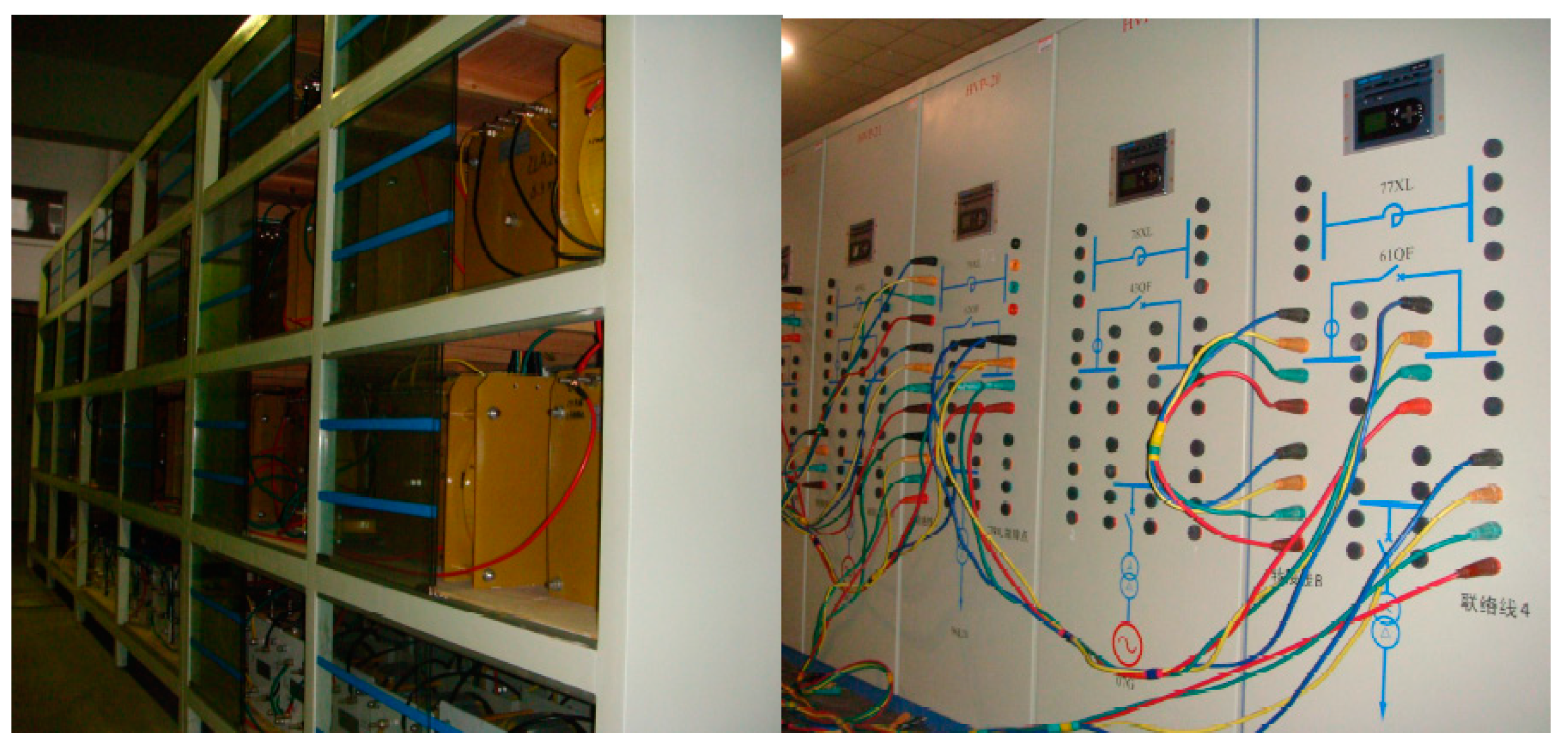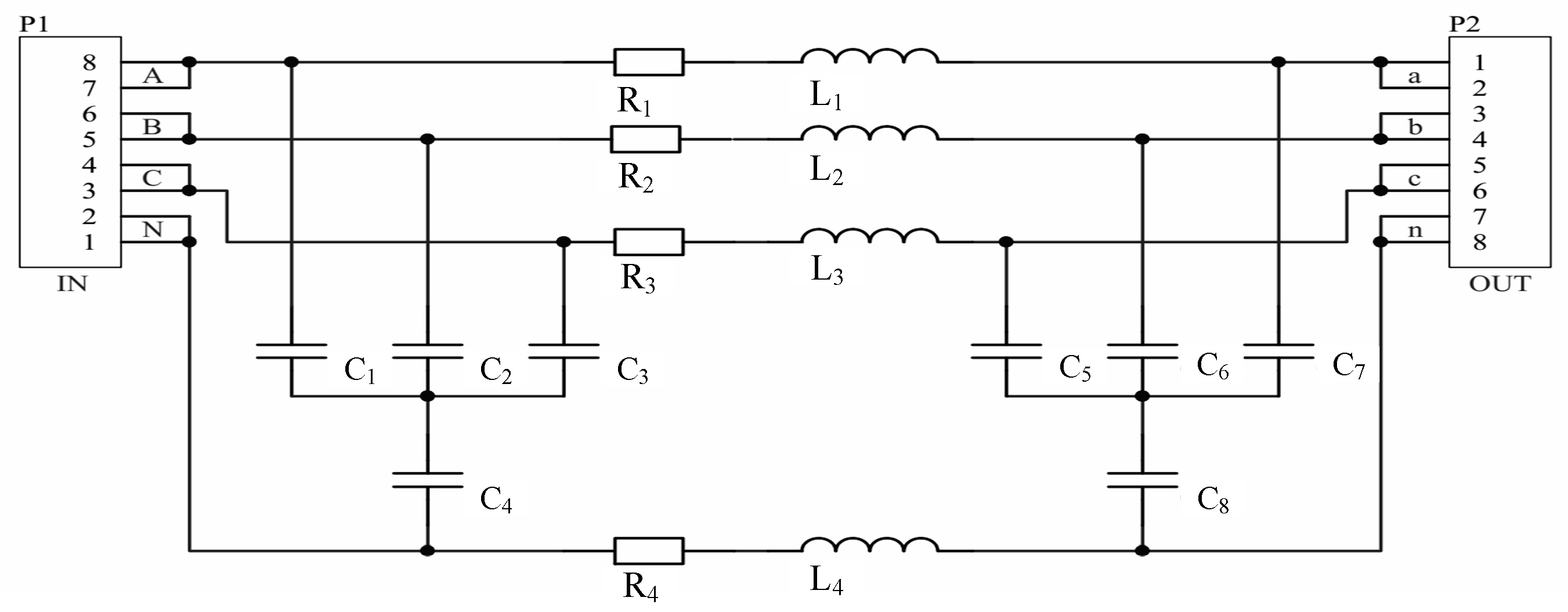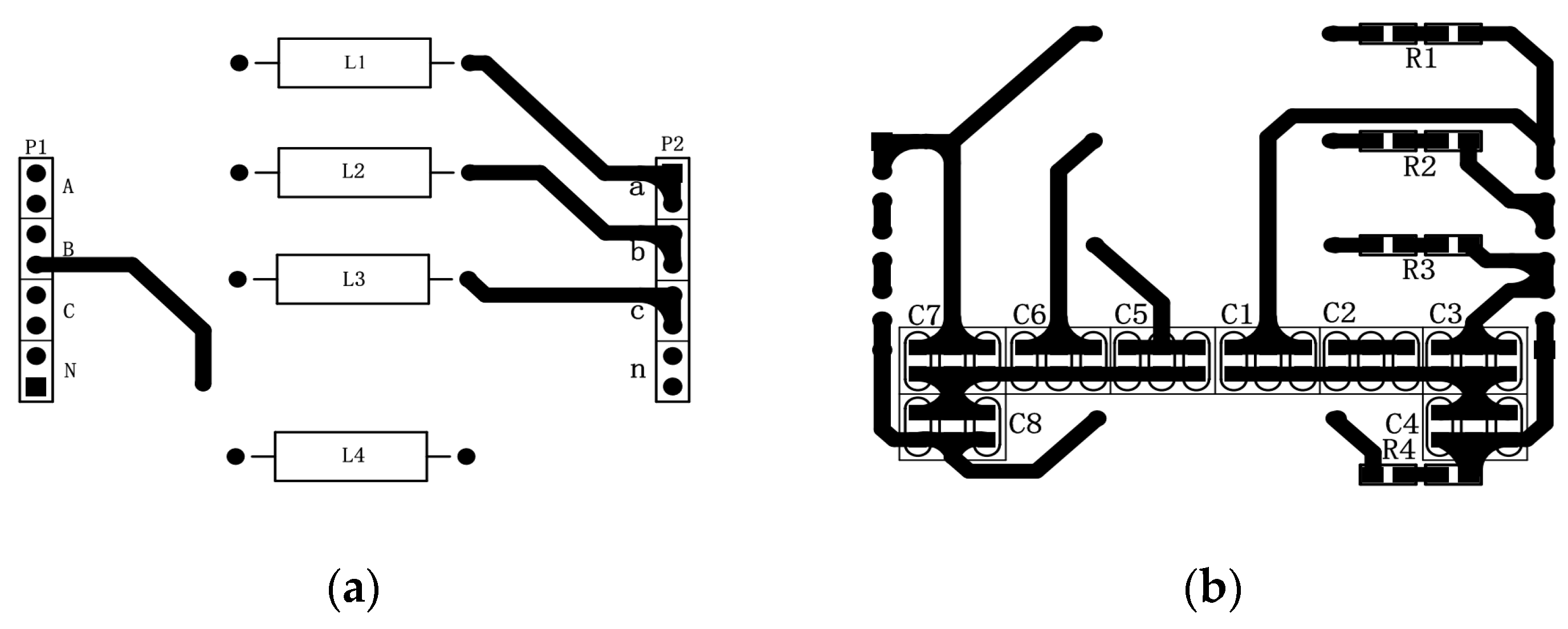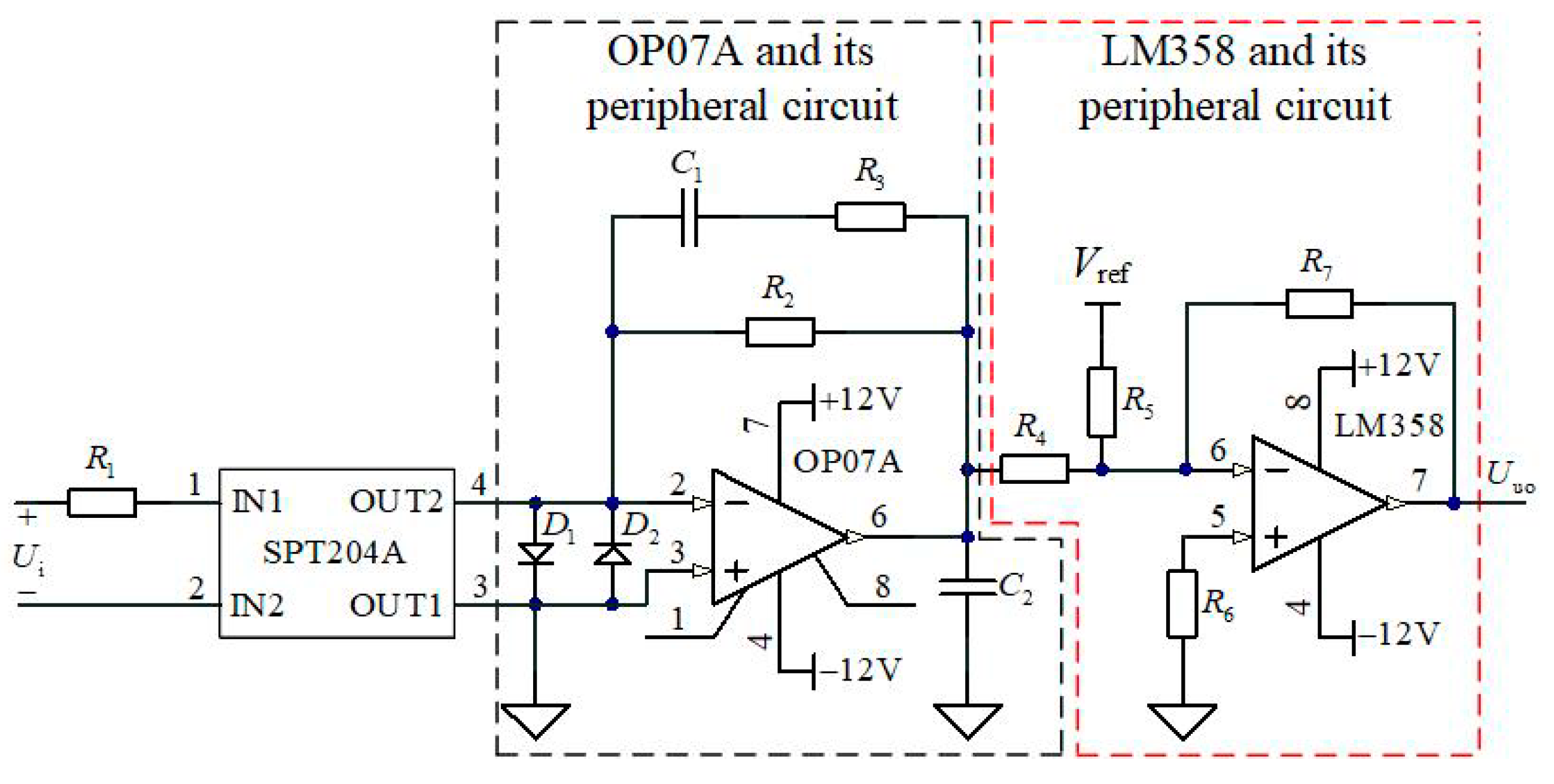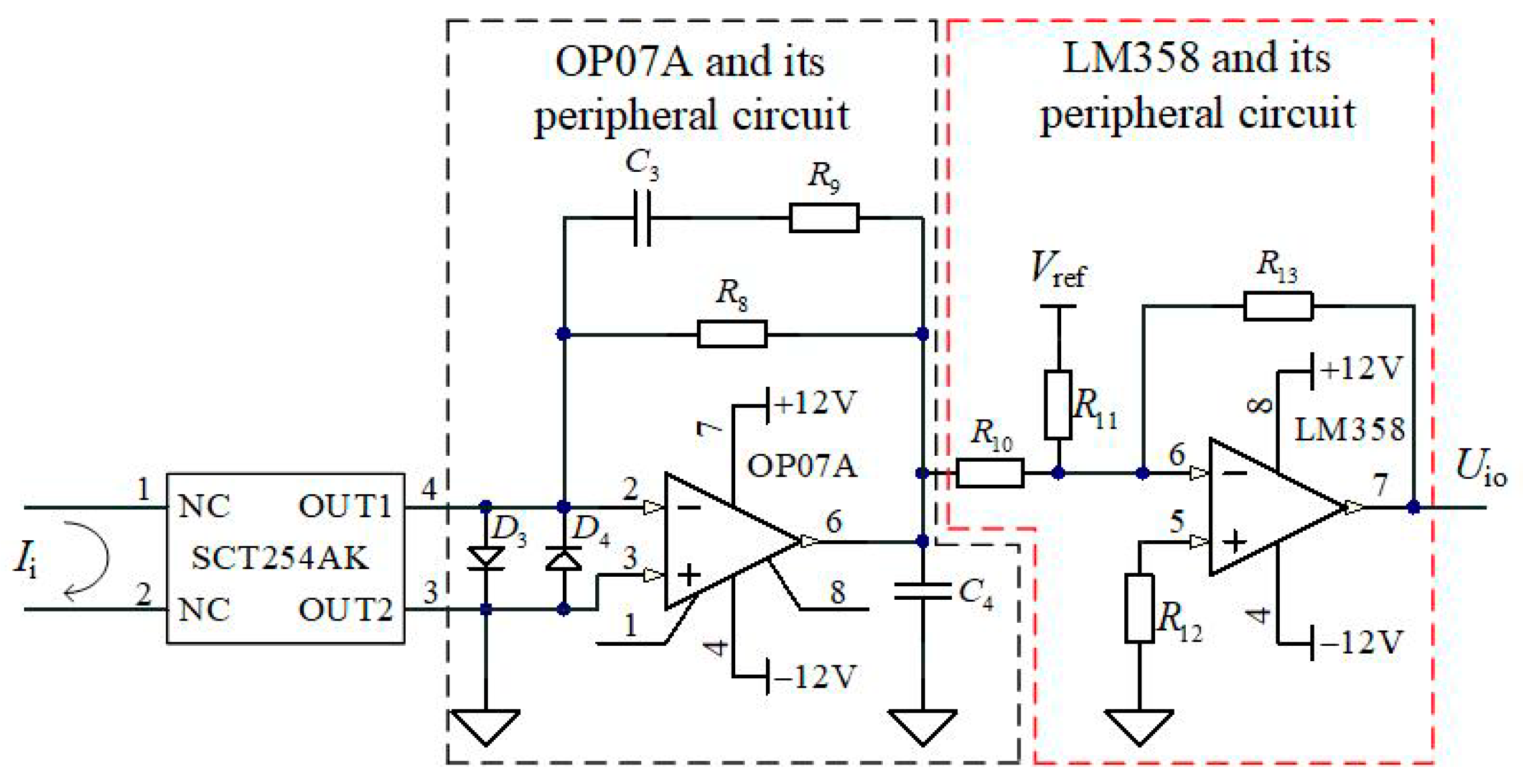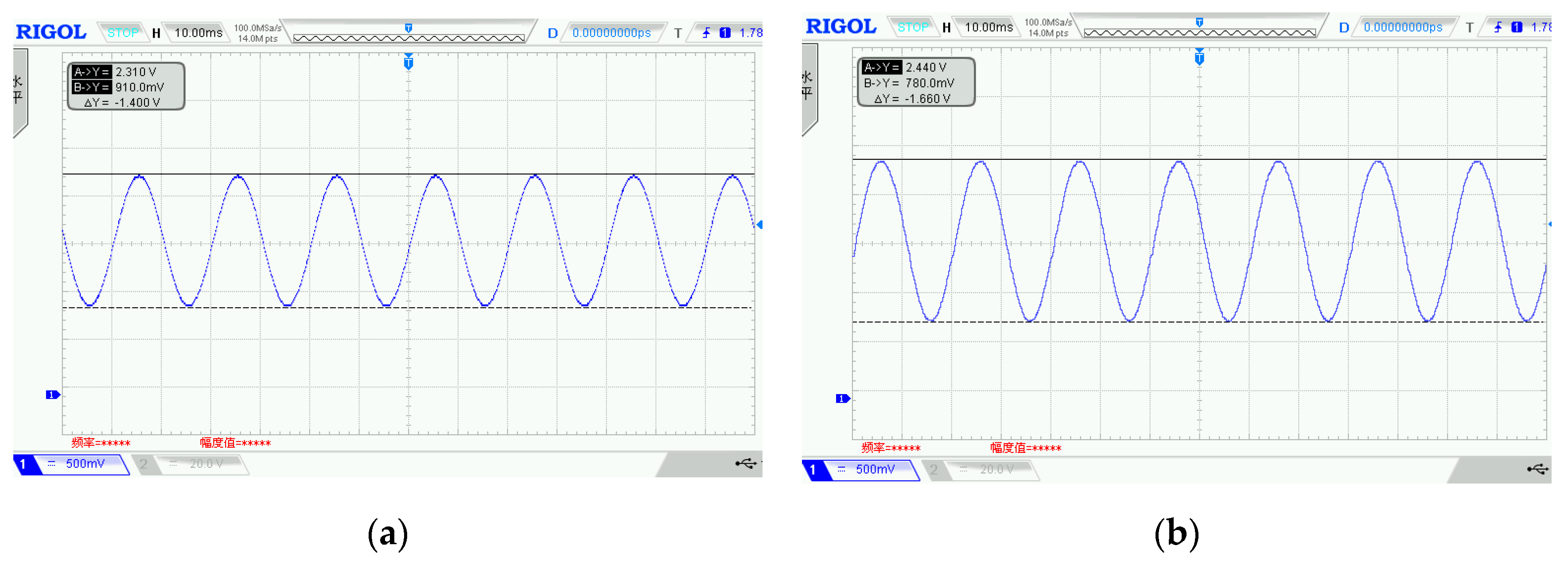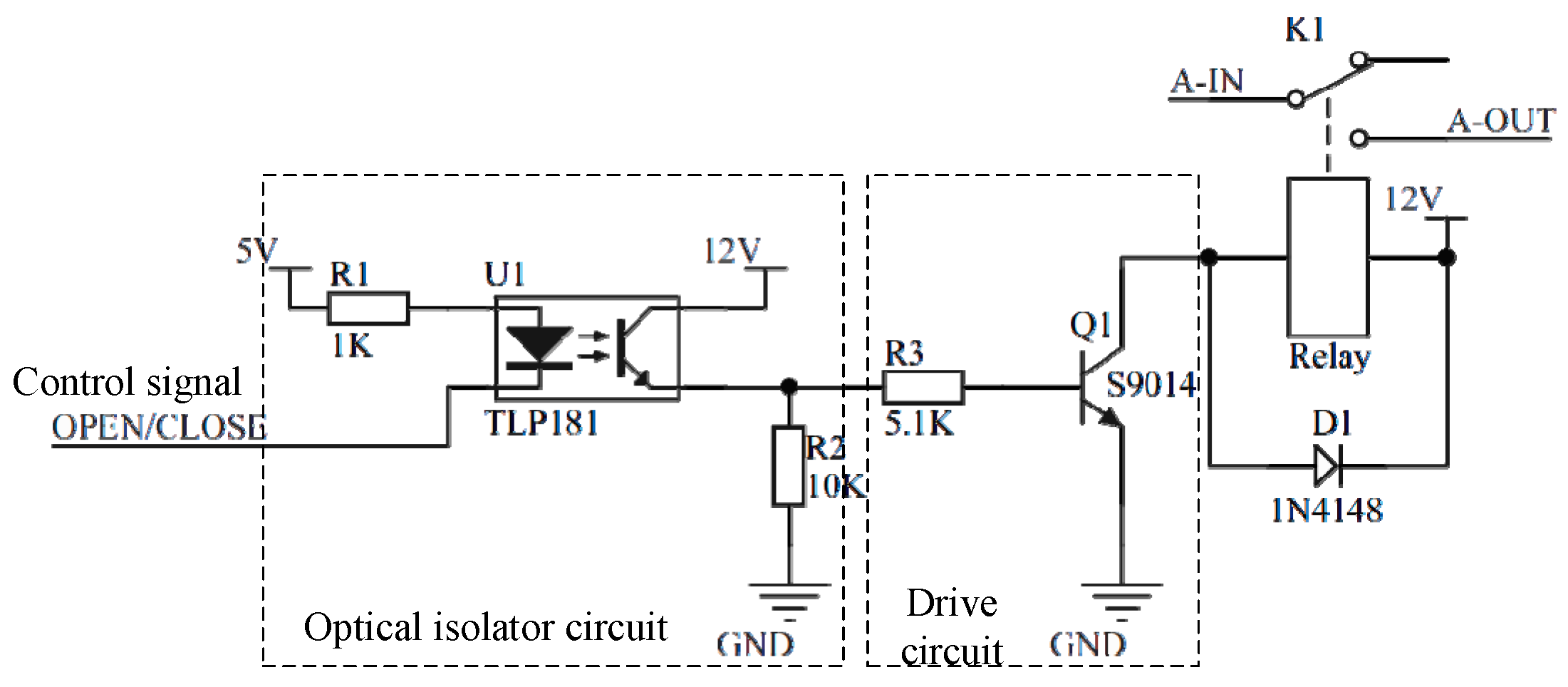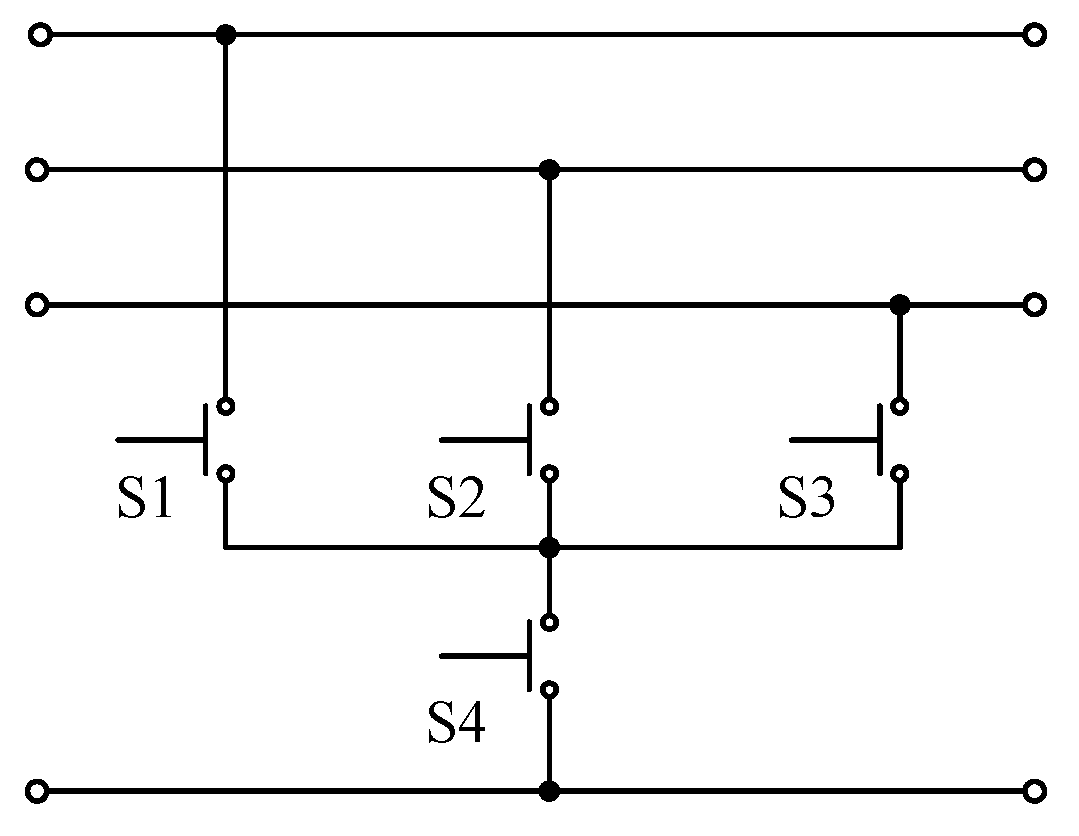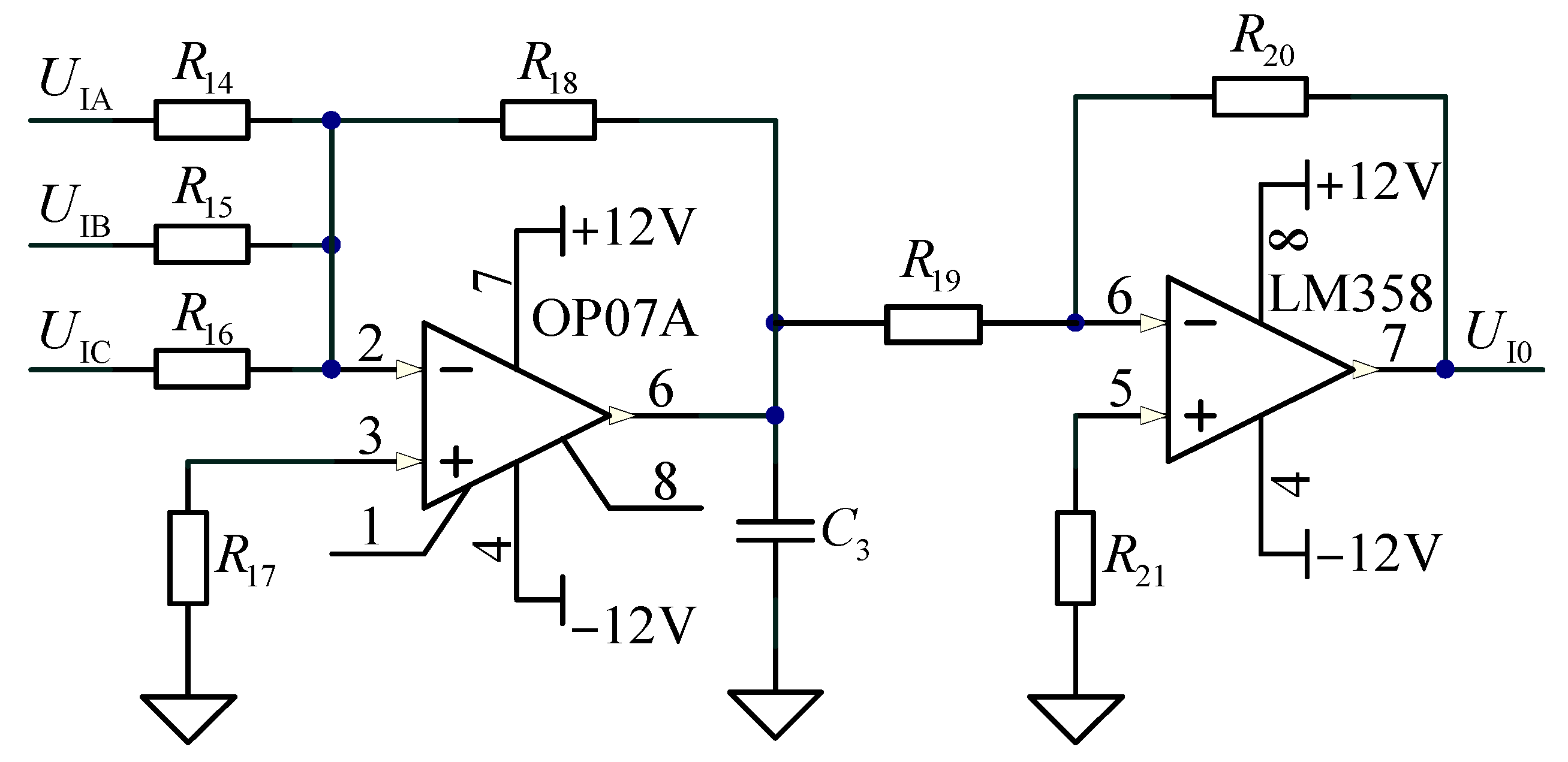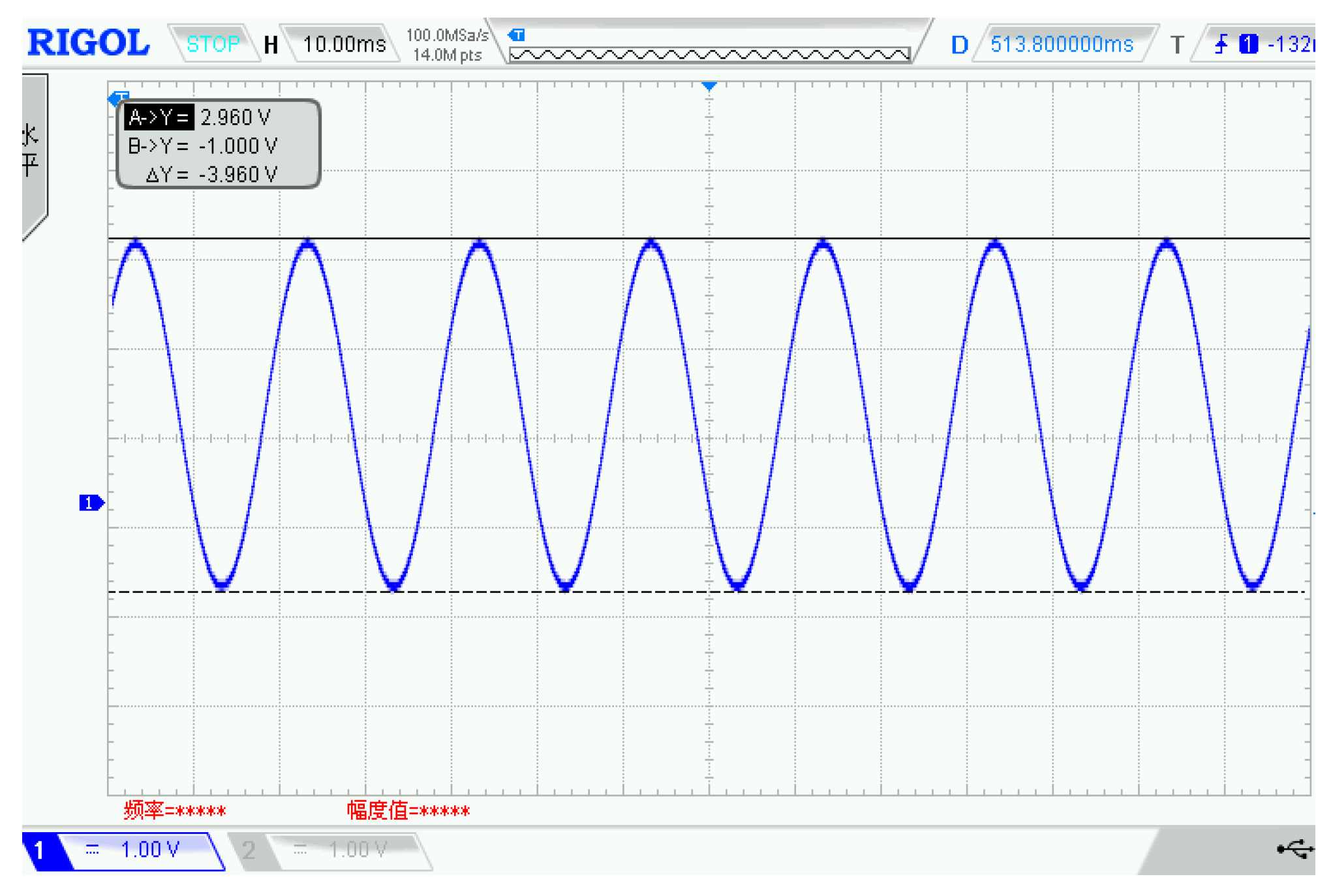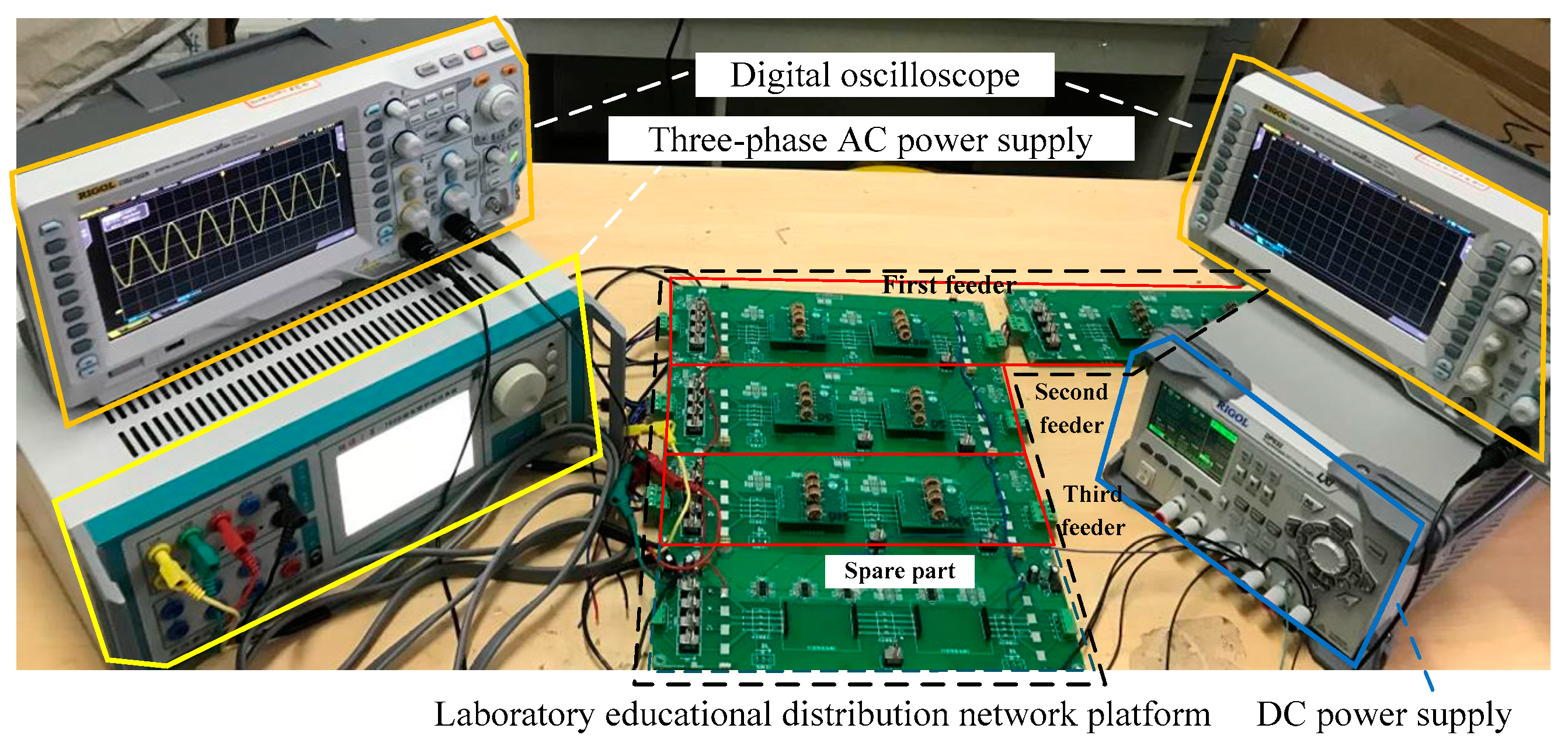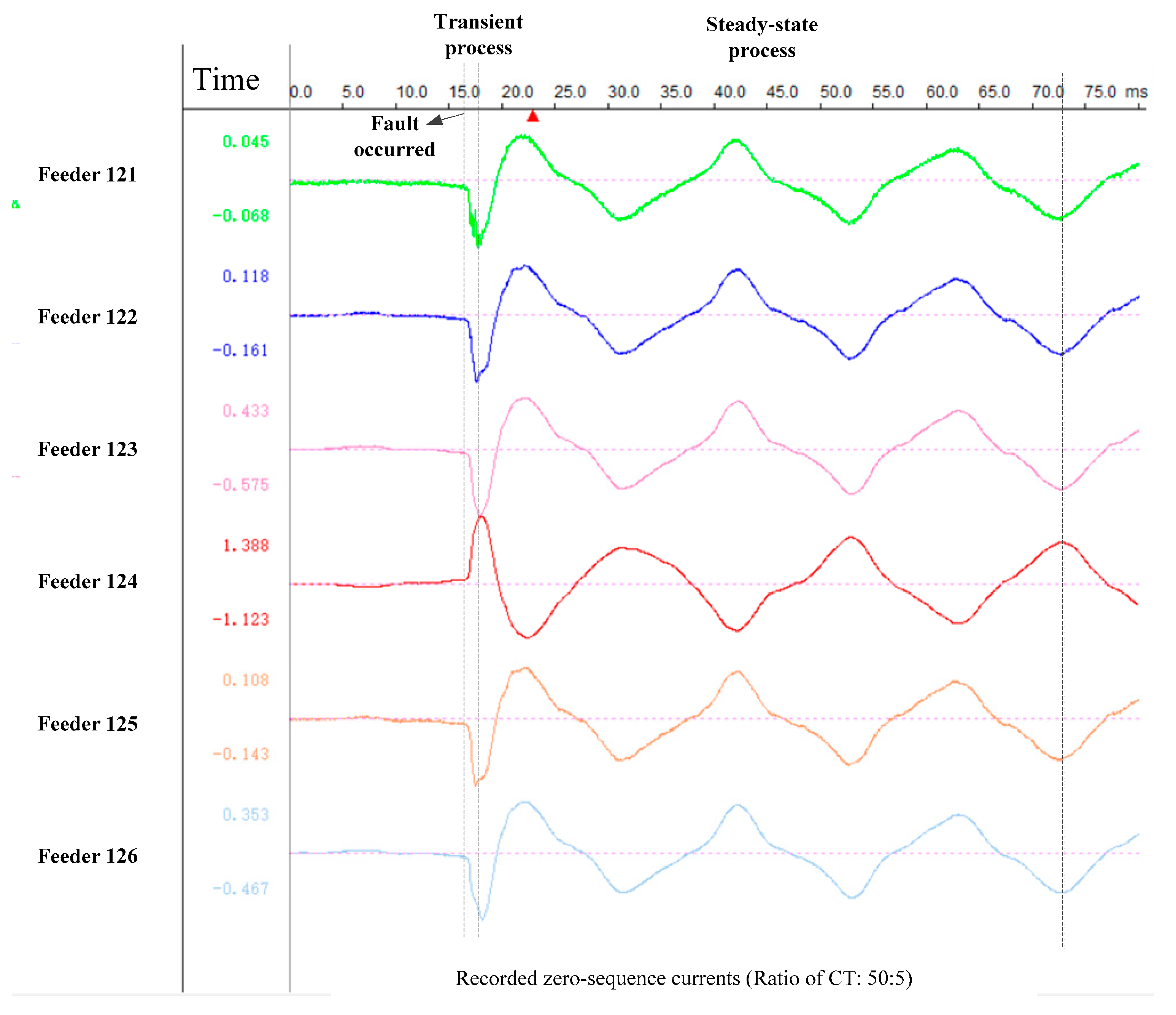1. Introduction
Laboratory education is an essential part of today’s university-level electric power engineering education. Various laboratory experimental platforms have been developed and widely used, with the aim to provide the students with theoretical knowledge and practical experience. Several decades ago, electrical machines and high voltage laboratories were constructed and used for teaching practical skills [
1]. However, as setting up a realistic power system in the laboratory environment is very complex and costly, digital simulation software is now commonly used in the laboratory education [
2,
3,
4]. The main shortcomings of the software-based power engineering education are that there is a lack of physical understanding of the phenomena and little hands-on experience can be provided [
5]. To overcome these problems, digital–physical hybrid simulated electrical power system platforms were proposed and realized to provide hands-on experience on some specific devices [
6,
7,
8,
9,
10,
11], such as distribution generators [
7] and protective relays [
8,
9,
10,
11]. One laboratory education tool of operation optimization in the distribution network was proposed in Reference [
7], where physical distributed energy generators are integrated into the tool, while two independent distribution systems are simulated in the digital real-time simulator. To improve the educational process of the protective relay systems, power-system-relaying laboratories were developed for testing the relay operating characteristics in References [
8,
9,
10]. Although industrial relays are used in these laboratories, pre- and post-fault signals are generated by a digital power-system simulator to test the relays. To observe the interactive behavior between relaying automation and the electrical distribution system operation, overvoltage and overcurrent protective relays were tested under a real-time environment with a constructed hardware-in-the-loop educational platform [
11]. In these proposed educational platforms, the electrical power systems are still reluctantly realized by digital simulation.
To provide students with the experience of observing electrical power system phenomena intuitively, many scaled-down power systems have been proposed and implemented to set up physical contact with the electrical world in the laboratory environment [
12,
13,
14,
15,
16,
17,
18]. References [
12] and [
13] show several scaled-down systems for demonstrating traditional power system operation features. In Reference [
14], a particular small power system composed of four nodes is constructed to illustrate the static VAr compensator operating characteristics. In Reference [
15], a particular scaled-down physical power system is designed and simulated for protective relay function demonstration and algorithm evaluation based on the structure of a 345 kV transmission system. Unlike the abovementioned scaled-down systems, power distribution system laboratory platforms (PDSLPs) are analyzed in References [
16,
17,
18,
19,
20,
21]. References [
16,
17,
18,
19] discuss the laboratory development of smart distribution grids consisting of various distributed generating units and/or energy storage devices. The major influence of distributed generations and storage devices exert in the operation of distribution systems is analyzed through real-time controllers and other components. Meanwhile, some other scaled-down PDSLPs used for particular experiments are introduced in References [
20,
21,
22]. The details of the multiphase radial power flow experiment and its corresponding hardware design, as well as the embedded monitoring and control system, are presented for the power distribution system education in Reference [
20]. In References [
21,
22], distribution automation laboratories are implemented and described in detail, and their functions mainly include fault location identification and feeder reconfiguration. In these laboratories, the focus of the education is the performance of fault location techniques under short-circuit fault with large fault current, while the single-phase earth fault location experiment in neutral non-effectively grounded distribution systems (NGDSs), which is still an attractive and challenging technology, cannot be demonstrated. In fact, further investigation shows that the single-phase earth faults are the most prevalent, accounting for about 80% of all faults [
23,
24,
25]. Moreover, NGDSs have been widely used in Central and Eastern Europe for many decades, as well as in China [
26]. Therefore, a PDSLP for fault location in NGDSs is selected as a typical experimental scenario and implemented in this paper.
A PDSLP for the fault location in NGDSs can be directly constructed by some commercial products, such as the ones from the companies Terco [
27], De Lorenzo [
28], and Lucas Nülle [
29]. However, the nominal voltage of the commercial experimental distribution system models is usually within 120–1000 V and the capacity of the scaled-down system is from tens to hundreds of kVA normally. Such systems are expensive and bulky for some schools. In the experiments, students have to use a number of wires to establish the electrical connections between various devices by hand. This work is time-consuming and tedious, and it can pose a safety hazard. Another disadvantage of the laboratory education using these commercial platforms is the lack of awareness about the principles and the characteristics of the equivalent electric power components, as these components are packaged and the internal structure is invisible to students.
To overcome the aforementioned problems, an integrated PDSLP using modular miniature physical elements is proposed in this paper. The printed circuit board (PCB) and microelectronic technology are proposed to construct each physical element. Furthermore, the constructed physical elements are used to set up an integrated PDSLP based on modular assembly technology. The main electrical elements, such as the three-phase transmission line module, can be realized in miniaturization by electronic components and PCBs. In addition, the elements can be efficiently and reliably connected by standard pin-outs. The reliability of the proposed integrated PDSLP can be greatly improved because the signal transmission path is shortened and a number of welding points are reduced. Then a PDSLP for fault location in NGDSs is implemented and discussed to prove the high performance of the proposed laboratory scheme.
The rest of this paper is organized as follows: In
Section 2, the architecture of the proposed integrated PDSLP is introduced. In
Section 3, the main modular miniature physical models used in the proposed platform are introduced, discussed, and validated, including the three-phase distribution line module, voltage/current monitoring circuit module, and short-circuit fault generator module. In
Section 4, the general miniature physical elements and specialized zero-sequence current signal monitoring circuit module are designed, and then, the effectiveness of the integrated PDSLP is validated experimentally. Students’ feedbacks are presented in
Section 5 to verify the positive effects of our proposed platform on power engineering education. The main findings are concluded in
Section 6.
2. Architecture of the Integrated Power Distribution System Laboratory Platform
In this section, the development requirements of the proposed integrated PDSLP need to be analyzed and illustrated. In our proposed scaled-down power distribution system, the main modules to be implemented include the three-phase distribution line module, voltage/current monitoring circuit module and short-circuit fault generator module, etc. Since the distribution feeders usually include overhead lines, underground cables, and combined underground cables and overhead lines, the three-phase distribution line module can be implemented by several standardized modules. Each standardized distribution line module represents one type of distribution line with a certain length.
The architecture of the proposed PDSLP is shown in
Figure 1. External power source, such as traditional protective relay tester with three-phase AC power output ports, is connected to the three-phase input port module, and then the following modules are connected in cascade one after another: Three-phase breaker module, voltage/current monitoring module, the first three-phase distribution line module, short-circuit fault generator module, the second three-phase distribution line module, and three-phase-load output port module. The three-phase distribution line module, short-circuit fault generator module, and voltage/current monitoring module will be introduced and discussed in
Section 3.
The physical models in the proposed platform are constructed by electronic components, so the PDSLP can be designed and implemented according to the PCB production process. The prototype of the proposed scaled-down PDSLP is shown in
Figure 2. It is a scaled-down distribution network with three feeders, and each feeder is constructed by two three-phase distribution line modules. To eliminate the safety problem and permit the open use of the miniature PDSLP, the maximum line-to-ground voltage is limited to 35 V. The total cost of this platform is about US
$1000, and the relevant equipment and its detailed cost in our proposed platform are listed in
Table 1.
Since there are usually dozens of distribution lines connected to the same substation bus, we constructed twenty three-phase distribution line modules and embedded them in ten PCB motherboards (the PCB motherboard is integrated with the voltage and current monitoring circuit module, short circuit fault generator and breaker module, the module of input, and out ports). Every two distribution line modules would be embedded into one PCB motherboard. Hence the total cost of our proposed platform reached about US $1000.
The cost comparison was carried out between our proposed platform and the commercial components in the common market [
27,
28,
29]. The detailed cost comparison is given in
Table 2. Compared with the cost of the commercial devices, it can be derived the cost of the distribution line module proposed in our paper was reduced by 98.9%, and the total cost of the proposed platform was reduced by 98.6%.
The size of the proposed platform was about 30 cm × 30 cm × 3 cm. The major devices included six PCBs of the distribution line module, three PCBs of the short-circuit fault generator module, nine PCBs of the voltage and current monitoring circuit module, one PCB of the three-phase input port module, three PCBs of the three-phase breaker module, and three PCBs of the three-phase-load output port module. For the traditional π-shape three-phase transmission line model implemented in References [
30,
31], the size of the one line model module was about 80 cm × 40 cm × 70 cm, which is shown in
Figure 3. If six traditional transmission line model modules were used to set up one distribution network with three feeders, the total size of the platform would be larger than 480 cm × 40 cm × 70 cm. In other words, the size of the proposed miniature PDSLP in this paper was about 0.2 percent of the size of the traditional platform.
5. Students’ Evaluation
The proposed platform was used for the undergraduate course “Power System Protective Relaying” at Wuhan University of Technology, China, during the second semester of 2017 and the first semester of 2018. In this course, the platform was used to explain the principle of overcurrent protection in the distribution network. The experiment designed based on this platform was fault location for the single-phase earth fault in the neutral indirectly earth systems. Three exercises were assigned to the students:
- (1)
Faulted line identification based on the magnitude difference of the steady-state zero-sequence currents.
- (2)
Faulted line identification based on the phase difference of the steady-state zero-sequence currents.
- (3)
Faulted line identification based on the polarity difference of the transient zero-sequence currents.
The objectives of this experiment were to make the student become familiar with zero-sequence current characteristics measured at the beginning of the distribution feeders once a single-phase earth fault occurs. In particular, students were exposed to the inapplicability of traditional overcurrent protection for single-phase earth faults in NGDSs and the influence of weak fault current and noise jamming on zero-sequence-current feature-based protection. The three exercises were also performed by computer-based simulation tools (e.g., Matlab/Simulink) during the course. At the end of the course, anonymous questionnaires were prepared and then filled by the students in order to get feedback regarding the exercises on our proposed platform. The responses on the questionnaires were analyzed and the final evaluation score is shown in
Table 7 (5 = Excellent, 1 = Very Poor).
A comparison of students’ survey responses between semesters shows that the proposed platform was positively reviewed by students. Response data collected from students indicated that students felt that the proposed platform could provide hardware-based experiments and immersive physical phenomenon visualization of fault location in NGDSs. Students also indicated that the power waveforms could be easily observed and recorded when a “real-world” single-phase earth fault occurred using the short-circuit fault generator module.
6. Conclusions
In this paper, an integrated power distribution system laboratory platform (PDSLP) was proposed for education purposes using modular miniature physical elements. The platform was implemented in a laboratory environment to provide students with the visualized experience on the distribution network phenomenon. Modular miniature physical elements, such as a three-phase distribution line module, were constructed by printed circuit boards (PCBs) and microelectronic technology. Furthermore, the constructed physical elements were used to set up the integrated scaled-down analogous electrical power systems based on modular assembly technology.
More specifically, a laboratory educational platform for fault location in neutral non-effectively grounded distribution systems (NGDSs) was selected as a typical experimental scenario in this paper. A scaled-down distribution network with three feeders was implemented and its nominal voltage was below 35 VL−L. The total cost of this platform was about US $1000, and the size of the proposed platform was about 30 cm × 30 cm × 3 cm. The zero-sequence currents of three feeders under a single-phase earth fault at different fault locations were measured and analyzed. It shows that the phase of the zero-sequence current of the faulted feeder was opposite to that of sound feeders, and the RMS value of the zero-sequence current of the faulted feeder equaled the sum of those of the sound feeders. Although the polarity of the zero-sequence current of the faulted line was always opposite to that of the sound line, the duration of most transient responses was less than 3 ms. Therefore, a high sampling rate was needed for the transient-information-based fault location algorithm.
In future, modular renewable energy sources and other elements will be designed, implemented, and integrated into the proposed platform. Then the proposed PDSLP can be extended to provide a multi-purpose and cost-effective platform and means for the laboratory education of the active distribution networks.
